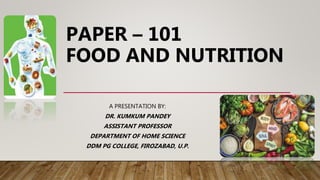Concept of nutrition, Food, nutrition, malnutrition and balanced diet
- 1. PAPER ŌĆō 101 FOOD AND NUTRITION A PRESENTATION BY: DR. KUMKUM PANDEY ASSISTANT PROFESSOR DEPARTMENT OF HOME SCIENCE DDM PG COLLEGE, FIROZABAD, U.P.
- 2. UNIT: 1 CONCEPT OF NUTRITION (A) Definition: Food, nutrition and balanced diet (B) Types of Nutrition: Optimum nutrition, under nutrition, over nutrition, malnutrition
- 3. (A) DEFINITION: FOOD, NUTRITION AND BALANCED DIET FOOD ŌĆ£Food can be defined as anything edible that can be solid, semisolid or liquid which when swallowed, digested and assimilated in the body, proves useful to it. These substances not only keep the person alive, but also provide energy used for growth and development, regulate the body processes and protect the body from diseasesŌĆØ. According to Rajmal P. Devdas
- 4. On the other hand ŌĆ£any substance intended to be, or reasonably expected to be, ingested by humans, which provides nutrients needed to maintain life considered as foodŌĆØ. It means whether in liquid, concentrated, solid, frozen, dried or dehydrated form, that are sold for ingestion or chewing by humans an are consumed for their taste or nutritional value. ŌĆó ŌĆ£Food: does not include alcoholic beverages, dietary supplements, soft drinks or tobaccoŌĆØ.
- 5. FUNCTIONAL FOOD ŌĆó DeFelice (2007) ŌĆ£Any substances that is a food or part of a food that provides medical and/or health bene’¼üts, including the prevention and treatment of diseaseŌĆØ. ŌĆó ŌĆ£Foods or food components that may have health bene’¼üts that reduce the risk of speci’¼üc diseases or other health concernsŌĆØ (National Institute of Nutrition, 2000)
- 6. NUTRITION ŌĆó Nutrition is the science that interprets the nutrients and other substances in food in relation to maintenance, growth, reproduction, health and disease of an organism. It includes food intake, absorption, assimilation, biosynthesis, catabolism and excretion.
- 7. ŌĆó Nutrition is a critical part of health and development. Better nutrition is related to improved infant, child and maternal health, stronger immune systems, safer pregnancy and childbirth, lower risk of non-communicable diseases (such as diabetes and cardiovascular disease), and longevity. ŌĆó People with adequate nutrition are more productive and can create opportunities to gradually break the cycles of poverty and hunger. (World Health Organization)
- 8. AIMS OF NUTRITION ’ā╝To educate people about good nutrition so that they can have complete physical and mental development. ’ā╝To educate about the cheap and easily available food sources so that every body can get adequate nutrition. ’ā╝Food described dependences of other related factors on nutrition like food related habits, care of food, personal hygiene and sanitation so that people can get proper nutrition.
- 9. BALANCED DIET ŌĆó A balanced diet means ŌĆ£getting the right types and amounts of foods and drinks to supply nutrition and energy for maintaining body cells, tissues, and organs, and for supporting normal growth and developmentŌĆØ. It is the diet that contain a variety of foods which fulfills the need for energy , amino acids , vitamins , minerals and other nutrients necessary for maintaining health, provides extra nutrients to withstand short duration of illness.
- 10. BALANCED DIET MUST CONTAIN- All these nutrients are present in the foods that we eat. Different food items have different proportions of nutrients present in them. The requirements of the nutrients depend on the age, gender, and health of a person.
- 11. Balanced diet should be planned according to- ’ā╝ Kinds of food produced in the region ’ā╝ Economic capacity ’ā╝ Religion of the person ’ā╝ Habit and interest of the people ’ā╝ Customs ’ā╝ Tastes
- 12. IMPORTANCE OF A BALANCED DIET The following are the importance of a balanced diet : ŌĆó Leads to a good physical and a good mental health. ŌĆó Helps in proper growth of the body. ŌĆó Increases the capacity to work ŌĆó Increases the ability to fight or resist diseases.
- 13. COMPONENTS OF A BALANCED DIET Some components of a balanced diet are as follows : ŌĆó Fats: Some part of our energy requirement is fulfilled by fats. Fats can be found in fatty foods such as butter, ghee, oil, cheese, etc. ŌĆó Proteins: We need proteins for growth purposes and to repair the wear and tear of the body. Protein also helps in building muscle. It is found in dairy products, sprouts, meat, eggs, chicken, etc ŌĆó Carbohydrates: We need the energy to process and it is fulfilled by carbohydrates. Carbs provide us energy. Carbohydrates can be found in rice, wheat, chapati, bread, etc. Cereals are our staple food. ŌĆó Minerals and Vitamins: Vitamins, Minerals, and Fibre improve the bodyŌĆÖs resistance to disease. We mainly obtain it from vegetables and fruits. Deficiency diseases like Anemia, Goitre, etc can be caused due to lack of mineral in the body.
- 14. (B) Types of Nutrition: Optimum Nutrition under nutrition, over nutrition, malnutrition
- 15. OPTIMUM NUTRITION The term "Optimum Nutrition" can be defined as eating the right amounts of nutrients on a proper schedule to achieve the best performance & the longest possible lifetime in good health, assuming that external negative influences like accidents & infectious diseases can be avoided.
- 16. MALNUTRITION ŌĆó Malnutrition is a condition that results from eating a diet in which one or more nutrients are either not enough or are too much such that the diet causes health problems. It may involve calories, protein, carbohydrates, vitamins or minerals.
- 17. MALNUTRITION ŌĆó Malnutrition refers to deficiencies, excesses or imbalances in a personŌĆÖs intake of energy and/or nutrients. ŌĆó The term malnutrition covers 2 broad groups of conditions. One is ŌĆśundernutrition, and the other is overnutrition that causes obesity and diet-related noncommunicable diseases (such as heart disease, stroke, diabetes and cancer). (According to WHO)
- 19. ŌĆó Undernutrition denotes insufficient intake of energy and nutrients to meet an individual's needs to maintain good health. ŌĆó Overnutrition is a form of malnutrition in which the intake of nutrients is oversupplied. The amount of nutrients exceeds the amount required for normal growth, development, and metabolism.



















